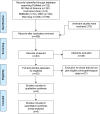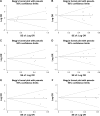Clinicopathological significance and prognostic role of p-STAT3 in patients with hepatocellular carcinoma
- PMID: 29551899
- PMCID: PMC5843139
- DOI: 10.2147/OTT.S156198
Clinicopathological significance and prognostic role of p-STAT3 in patients with hepatocellular carcinoma
Abstract
Background and aim: Constitutive activation of STAT3 through its phosphorylation (p-STAT3) plays a key role in the development and progression of various cancers. However, the relationship between p-STAT3 expression and the clinicopathological features and prognostic value in patients with hepatocellular carcinoma (HCC) remains controversial. We conducted a meta-analysis to evaluate the role of p-STAT3 in HCC.
Methods: The PubMed, Cochrane Library, Web of Science, EMBASE, Chinese CNKI, and Chinese Wanfang databases were searched using the appropriate terms to find the relevant studies on p-STAT3 and HCC. The relationship between p-STAT3 expression and clinicopathological characteristics and prognostic value was established. Pool odds ratios (ORs) and hazard ratios (HRs) with 95% CIs were calculated using the STATA 14.2 software.
Results: The eight articles included in this meta-analysis comprised 752 patients. Expression of p-STAT3 was associated with incidence, age, liver cirrhosis, tumor size, vascular invasion, and TNM stage of HCC, but it was not related to gender, alpha-fetoprotein (AFP), hepatitis B surface antigen (HBsAg), number of tumors, and tumor differentiation. Additionally, the expression of p-STAT3 was related to a poor 3- and 5-year overall survival rate and disease-free survival rate.
Conclusion: Expression of p-STAT3 was associated with the incidence, age, liver cirrhosis, tumor size, vascular invasion, and TNM stage. Thus, p-STAT3 can be a reliable prognostic biomarker for HCC. Further high-quality studies with larger numbers of patients are needed.
Keywords: hepatocellular carcinoma; meta-analysis; p-STAT3; prognosis.
Conflict of interest statement
Disclosure The authors report no conflicts of interest in this work.
Figures





Similar articles
-
Clinicopathological and prognostic significance of OCT4 in patients with hepatocellular carcinoma: a meta-analysis.Onco Targets Ther. 2017 Dec 21;11:47-57. doi: 10.2147/OTT.S151390. eCollection 2018. Onco Targets Ther. 2017. PMID: 29317833 Free PMC article. Review.
-
Prognostic and clinicopathological value of Nanog in hepatocellular carcinoma: A meta-analysis.Clin Chim Acta. 2018 Feb;477:24-31. doi: 10.1016/j.cca.2017.11.037. Epub 2017 Dec 2. Clin Chim Acta. 2018. PMID: 29198990
-
Clinicopathological and prognostic significance of FoxM1 in hepatocellular carcinoma patients: a meta-analysis.Onco Targets Ther. 2018 Jun 19;11:3561-3571. doi: 10.2147/OTT.S155541. eCollection 2018. Onco Targets Ther. 2018. PMID: 29950861 Free PMC article.
-
Role of Beclin1 expression in patients with hepatocellular carcinoma: a meta-analysis.Onco Targets Ther. 2018 Apr 27;11:2387-2397. doi: 10.2147/OTT.S151751. eCollection 2018. Onco Targets Ther. 2018. PMID: 29740214 Free PMC article.
-
Prognostic and clinicopathological significance of MACC1 expression in hepatocellular carcinoma patients: a meta-analysis.Int J Clin Exp Med. 2015 Apr 15;8(4):4769-77. eCollection 2015. Int J Clin Exp Med. 2015. PMID: 26131051 Free PMC article. Review.
Cited by
-
Interfering with the AKT/mTOR/STAT3/ID1 signaling axis with usenamine A restrains the proliferative and invasive potential of human hepatocellular carcinoma cells.Chin Med. 2024 Jan 5;19(1):4. doi: 10.1186/s13020-023-00875-w. Chin Med. 2024. PMID: 38183094 Free PMC article.
-
STAT3 and STAT5 Activation in Solid Cancers.Cancers (Basel). 2019 Sep 25;11(10):1428. doi: 10.3390/cancers11101428. Cancers (Basel). 2019. PMID: 31557897 Free PMC article. Review.
-
Hepatocellular carcinoma cells downregulate PGAM2 via SIRT2-mediated deacetylation modification to enhance aerobic glycolysis.NPJ Precis Oncol. 2025 May 16;9(1):143. doi: 10.1038/s41698-025-00930-9. NPJ Precis Oncol. 2025. PMID: 40379975 Free PMC article.
-
NT157 Inhibits HCC Migration via Downregulating the STAT3/Jab1 Signaling Pathway.Technol Cancer Res Treat. 2021 Jan-Dec;20:15330338211027916. doi: 10.1177/15330338211027916. Technol Cancer Res Treat. 2021. PMID: 34238066 Free PMC article.
-
STAT3: An Emerging Therapeutic Target for Hepatocellular Carcinoma.Cancers (Basel). 2019 Oct 25;11(11):1646. doi: 10.3390/cancers11111646. Cancers (Basel). 2019. PMID: 31731457 Free PMC article. Review.
References
-
- Siegel R, Naishadham D, Jemal A. Cancer statistics, 2012. CA Cancer J Clin. 2012;62(1):10–29. - PubMed
-
- Chen W, Zheng R, Baade PD, et al. Cancer statistics in China, 2015. CA Cancer J Clin. 2016;66(2):115–132. - PubMed
-
- Forner A, Llovet JM, Bruix J. Hepatocellular carcinoma. Lancet. 2012;379(9822):1245–1255. - PubMed
-
- Avila MA, Berasain C, Sangro B, Prieto J. New therapies for hepatocellular carcinoma. Oncogene. 2006;25(27):3866–3884. - PubMed
LinkOut - more resources
Full Text Sources
Other Literature Sources
Miscellaneous

